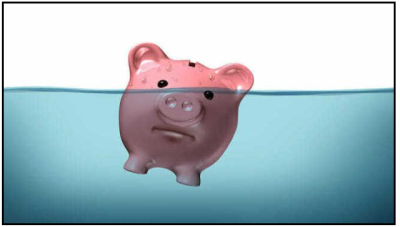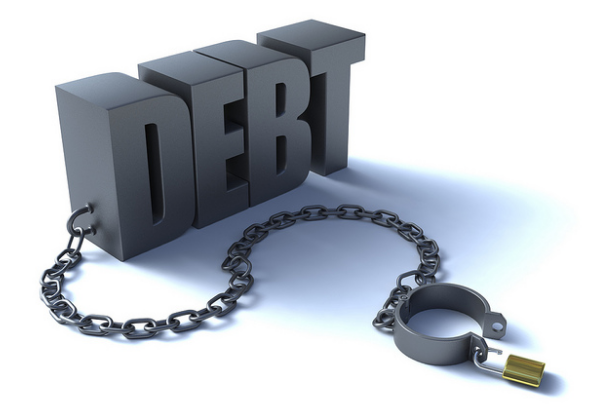How to Control Your Debt to Income Ratio – A Guide For Beginners

While debt to income ratio might sound like a metric more suited to accountants and financial professionals, your personal debt to income ratio is something that you should know and track.
For starters, financial institutions use the debt to income ratio in determining whether to grant you credit, including loans for mortgages.
Additionally, the debt to income ratio is a strong indicator of your overall financial position.
If you’re wondering how to calculate debt to income ratio, it’s actually quite simple. Divide all of your recurring monthly debt by your gross monthly income.
For example, if you have $1,000 in monthly debt across your credit cards, car payment, mortgage, and other types of debt, and $2,900 in gross monthly income before taxes, your formula would look like this: 1,000 / 2,900 = 34%.
What is a good debt to income ratio? For most purposes, the debt to income ratio should be no more than 36%.
It is not uncommon for your debt to income ratio to change as you take on new debt and pay off old debt, but in general, an acceptable debt to income ratio would usually fall below 36%.
How to Lower Your Debt to Income Ratio
If you do the calculations and find that your debt to income ratio is above 36%, learning how to lower the debt to income ratio should be a priority.
A high debt to income ratio not only impacts creditworthiness but can also lead to stress when you are in over your head with debt.
There are two ways to reduce your debt to income ratio: Either reduce your debt or increase your income.
Of the two, reducing your debt is usually the more realistic means to lower your debt to income ratio. Here are a few methods you can use to accomplish this while learning how to reduce debt to income ratio:
- Avoid the temptation to accumulate more debt by removing yourself from the mailing lists that send you attractive credit offers. Learn how you can do this with Stumble Forward’s article on stopping junk mail once and for all.
- Control your debt and make better use of your income by prioritizing repairs to your home, car, and other possessions. Repair bills tend to escalate as problems with these big-ticket items tend to spread. Learn how to prioritize by performing yearly home maintenance and minimizing further debt accumulation.
- Increase the monthly amount you are paying on your debts. As Bank of America points out, extra payments are applied to principal, which reduces your debt and prevents further interest accumulation more quickly.
- Write off bad debt. Your final option is to write off this debt using a very specific process. You can get this bad debt write off form here and follow the process.
Your Debt to Income Ratio and Mortgages
If you are preparing to apply for a mortgage, whether it’s a new primary mortgage or a second mortgage on your existing home, your debt to income ratio may be a critical factor in your loan’s approval.
If you have a high debt to income ratio, you should start working on lowering it well before you anticipate applying for a mortgage.
But what is the debt to income ratio for mortgages? According to LendingTree, there are no hard and fast rules, but most lenders prefer to see a debt to income ratio below 36%.
Additionally, your household expenses that are not debt – for example, utilities, groceries, and transportation costs – should not exceed 28% of your gross monthly income.
Yet there are exceptions, notably with Federal Housing Authority and Veterans Administration-backed mortgages, which may allow debt to income ratios of up to 41%.
Make it a New Year’s resolution to calculate your debt to income ratio by collecting your monthly debt costs and calculating your gross monthly income. If your debt to income ratio is close to or above 36%, it might be a good idea to focus on reducing it in the New Year.
On the other hand, if your debt to income ratio is below 36%, you now have the motivation and knowledge you need to keep your debt to income ratio healthy.





Laura, great article. I especially like the tip about keeping your home maintained in order to avoid big repair bills later on. I might add too that, even if your DTI ratio is high, you can likely still scrounge up a few extra dollars to put toward paying off debt quicker. Every little bit helps. Thanks for the great post!
That’s a good tip Laurie. Paying down your home with extra cash can go a long way to keeping your debt to income ratio low and also cut down on the amount of interest you pay over time as well. So in a way it’s kind of like a double edge sword. Thanks for stopping by an sharing your thoughts.
Nice article. This is something that many people overlook or have no idea what their ratio is. This is also great to check out once you start a new year. Work throughout the year to decrease the percentage.
That’s what I’ll defiantly be doing this your Grayson. I had to purchase some new appliances and I had to use my credit card to carry some of the weight while I build my house so I’m currently working to get that paid off ASAP.
Good points. My ratio was pretty high at one point, so I ignored it. Not smart. It’s better to be aware and do everything you can do to lower it.
Good post! Debt sucks. It’s best to just pay it all off as soon as humanly possible!
This is a nice reminder. Not many people consider total debt vs total income. As a result they keep incrementally increasing their debt load until it overtakes their income level!
I agree Holly, whenever I get a debt it typically bugs me quite a bit until I get it paid off. I guess I can kind of look at that like a good habit.
Yeah I defiantly wouldn’t ignore your DTI Kim, but that’s how we all learn, in fact that how I learn so much about most of my finances. I’m actually in a pretty good position with my DTI right now which is great since I’m building a house. Currently, I’m looking at get a 3.5% interest rate or better on my mortgage which is unbelievable for me.
Good point Marie, that’s what got me into trouble a few years back with my DTI. Back several years ago I was adding a little debt here and there and the next thing you know I had a real problem on my hands. I think this is how most people get into trouble with their money. Fortunately, I was able to get things straightened out in a few years and save up a few bucks.
Thanks for stopping by Marie, I will defiantly have to check out your blog.
Good post! Sadly too many do not know what their ratio is, or how to even figure it. Thankfully we’ve been able to get ours pretty low as all we have left is our mortgage. That alone is still pretty low considering what is often thought of as “average”.
Great article. Most people don’t even know what you’re talking about, which is how most of them even up in messes that take years to clean up.
That’s awesome that all you have left is your mortgage John. I brought on a little more debt since I’ve started building my house but I should be down to my mortgage again in the next several months again.
Good point Marissa a lot of people don’t know what a debt to income ratio is, how it works, or even why it’s so important. To be truthfully honest I didn’t even know what it was until I was studying to be a financial planner. Thanks for the comment.